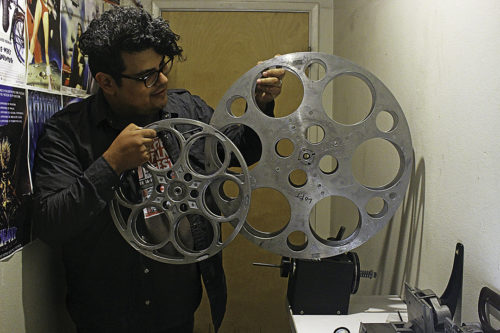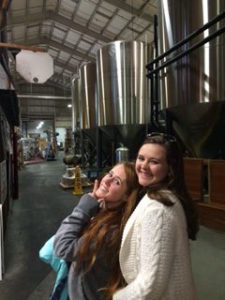By ALEXIS WRIGHT
Arizona Sonora News
Sweat collects on his brow, salty and profuse. He absentmindedly wipes it away with a roll of his shoulder and focuses on the gritty process in front of him.

Pedro Robles-Hill looks up. The machine is still operating with no clogs, rips or tears in the mechanisms. Its loud and grinding sound labors with almost hypnotizing precision, while the heat increases to almost uncomfortable levels. He pushes forward.
A glance at the time reminds him that he has only been at work for only a half an hour, with another hour or two before he can escape to a cool haven, a chair and maybe the bathroom.
Those hours fly by, and before he knows it, his task is done.
For a projectionist contending with the fading chore of running film in a digital age in an “arts” movie theater like the Loft Cinemas in Tucson, the job is never quite finished.
After a transition period for over a decade, using mechanical projectors to show movies on film is a nearly extinct process.
In 2015, more than 97 percent of the roughly 45,000 commercial movie screens in the United States use digital projection, according to data from the Motion Picture Association of America.
Some filmmakers, among them the director Quentin Tarantino, have disparaged this transition away from film, the standard for movie projection for most of the history of the movies.
Digital moviemaking, Tarantino lamented at the Cannes Film Festival in 2014, represents “the death of cinema.” While digital movies are easier to shoot and to exhibit in highly automated modern movie cineplexes, images on 35-millimeter film are richer in texture and far better yet are the 70-millimeter film that select movies used to be produced in, say Tarantino and others who mourn the demise of film.

However, even as the digital revolution reached near supremacy on location and in the projection booth, a strange event transpired.
A fairly small number of movie exhibitors — the industry’s term for theater operators — decided to revive the old 70-millimeter technology. They’ve bought up and refurbished old 70-millimeter projectors, scoured Hollywood film libraries for the relatively few movies produced using the expensive technique. They even have trained employees working projection booths the old-fashioned way, though their lives aren’t in danger like they once were, with film formerly composed of silver nitrate.
The Loft, located on East Speedway, is a nonprofit cinema that shows many movies that would otherwise go unseen on a big screen. As one of the major players on the national circuit of what used to be known as “art house” cinemas, the Loft is digitalized for the most part, but says it maintains a commitment to showing movies in 35-millimeter film when available.
For exhibitors showing movies on film, the difference between 35-millimeter and 70-millimeter prints is the size of the film that runs through the projector. A 70-millimeter print has more clarity and a far higher visual resolution than 35-millimeter film or high-definition 4-K digital, said Jason Denholm, director of operations for the Loft.
Print is more expensive to process than digital and it is harder to distribute, requiring the shipping of the heavy reels of physical film itself to a theater. By comparison, digital movies are easily distributed via hard drives, Denholm noted.
In a typical modern cineplex, digital movies are projected onto various screens essentially with the flip of a switch. Projecting movies the old-fashioned way, on film, means maneuvering reels, monitoring the physical film as it trundles through the projector, and even skillfully switching from one projector to another as a reel runs out. That requires a skilled hand in the booth.
Pedro Robles-Hill is such a projectionist.
He said he initially started off working at a Century cineplex projecting 35-millimeter film in the years before digital became the standard. Once it made the shift, “I had to find ways to keep doing it,” Robles-Hill said of his love for film projection.
For him, there’s more to the job than just pressing a button.
For every movie shown in film, the Loft does a “dry run,” including to make sure each print has good sound quality. After checking each reel, setting up the film is another process for the projectionist. Since each standard movie comes in an average of eight reels, and with each reel playing for about 15 to 20 minutes, there is no rest for the projectionist running the show.
Depending on the size of the print film, the reels can be a manageable weight or they can get excessively heavy. “My arms are a little less tired after a shift,” Robles-Hill said, comparing the weight of 35-millimeter reels versus 70-millimeter reels.
In recent decades, most 35-millimeter projection systems required a projectionist to splice the individual reels of film together onto one oversized horizontal platter, so the entire film runs continuously through a single projector, without a need to change over to a second projector. Yet, the Loft utilizes a vertically designed projector that only holds one reel at a time, so more than one projector is needed to run a movie.

What happens is that the reel holding the one part of the film is manually loaded onto the top part of the projector, with the print being fed into a series of turning knobs. The film is then transferred to another, empty reel at the bottom to hold it until the projectionist can put the print back on the original reel after the movie ends.
If the print is a 35-millimeter one, the sound is fed through a knob that reads an narrow line that runs along the edge of the film to a surround sound system. The 70-millimeter print uses a stereo system that the projectionist also has to manually start.
Making sure the projectors change seamlessly from reel to reel is daunting, but Robles-Hill jokes that it gives him an adrenaline rush.
The comeback of 70-millimeter film embraced this year by the Loft was partially thanks to Tarantino insisting that his 2015 movie Hateful Eight, which he insisted on filming in 70-millimeter, be distributed and shown in 70-millimeter, said Joshua Gleich, associate professor of the School of Theater, Film and Production said at the University of Arizona.
The Loft and other theaters in the U.S. are driving new interest in the lush visual images afforded by 70-millimeter film and in finding 70-millimeter prints available to be shown using an expensive technology that, even in its heyday, accounted for only a small number of movies released.
Typically, they were expensive “blockbuster” films and epics, made in 70-millimeter for first-run showings in major movie houses and then converted to 35-millimeter for wider theatrical distribution.
This makes it possible for some theaters to show historical and old movies in print again, such as mint copies of epics like Lawrence of Arabia with Peter O’Toole and Omar Sharif, among others.
In January, meanwhile, the Loft joined the trend to show movies made on 70-millimeter film.
Movies in 70-millimeter on the Loft’s “70mm Showcase” agenda for this year include Aliens (1986) to be shown on Oct. 23 and 25, and a repeat of 2001: A Space Odyssey on Dec. 18 and 20.
In this day and age though, projectionists and cinema lovers are working to keep film alive. “I’m going to do it as long as I can,” Robles-Hill said. “This is what I would call a dream job.”
###

After college, Alexis Wright plans on going into publishing or business management. Born and raised in Vancouver, she found herself in Tucson for school. Her passion for baking erupted into a full-blown addiction. You can usually find her testing recipes or scouring the city to find the best happy hour.
Download high resolution images here.

